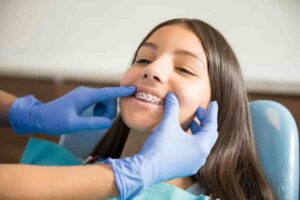If you are finding financial assistance for braces, you have come to the right place. Do you know how to apply or qualify for brace assistance? Only a few people know that governments and charities provide financial assistance for people who need braces for their teeth.
The chances of finding an orthodontist who works Pro Bono or a program covering 100% of your expenses are scarce, and you can’t directly ask for free braces.
For this, you should know which door to knock on for help. So, we have prepared a list of programs and organizations offering braces support. Continue to read this post to learn more about how to get financial assistance for braces.
Top 9 Financial Assistance For Braces Programs
Various non-profit and charity organizations in the USA offer multiple kinds of financial aid programs to people in need. And some of them also provide grants for braces.

Non-profits can sometimes help pay for dentures. They may receive government funding (rarely) or rely on the work of donors (usually). Therefore, they often do not have the resources and scope to help every needy family.
At least three non-profit organizations offer “generic” orthodontic treatment – with a moderate application fee and a family deposit of $ 200 after paying 6 50,650. First, you should go to the official website of these charities and look for more information.
1. Smile Change Live Program
No more searching for financial assistance for braces, as Smile Change Live Program is the best place to start. Low-income families can apply for the Smiles Change Lives program.
It provides access to orthodontic treatment for children between the ages of 11 and 18. If agreed, the child will get braces of $ 250 to $ 500.
To be accepted for this program, you must meet specific income requirements (for example, a family of four cannot earn more than $40,000 per year), and your child’s teeth must be moderately curved.
2. Smile for a Lifetime
Smile for Lifetime is a non-profit organization specializing in children needing orthodontic treatment with dentists interested in providing pro bono care. These services range from general orthodontic care to oral surgery and other necessary procedures. If you wonder how to get braces for free, Smile for a lifetime is your answer.
They prioritize services for low-income families and/or individuals in exceptional circumstances, such as foster care or out-of-home placements.
Because of these challenges, many young people are at risk for adverse health, educational and social outcomes. They are particularly vulnerable when they lack the positive self-esteem and confidence that comes with good oral health.
They aim to inspire hope in these young people and dramatically change their lives.
Must Read: How to Get Rid Of Traffic Tickets In Collections?
How To Get Braces For Free?
3. Donated orthodontic services
Members of the AAO-American Association of Orthodontists volunteered to provide high-quality orthodontic care for children from financially needy families. DOS orthodontists have helped 914 patients nationwide by delivering more than 5 million dollars.

Applicants must meet the eligibility criteria to get this financial aid. Their age must be between 7 to 18 years. They should have good oral hygiene and no unfilled cavities. The family income should be below the poverty line. The patient should have a recommendation letter.
Patients should have volunteer community service experience. And also have C+ or above GPA. When patients fulfill these requirements, then they can apply for this help.
4. Government funding
There is no direct government funding for free braces. The federal government provides financial assistance to universities, state institutions, non-profits, and individuals with personal needs.
And some of these grants can be useful for braces and other dental expenses. The government help paying for braces.
You should frequently check on the Grant.Gov website for such grants.
However, patients can identify the grant dollar to Orthodontia by following the path of money. They can help paying for braces without having to be awaited for the benefits.
Search for opportunities and awards to determine if any local university, agency, or organization has received dental care funding. So, these are the government programs that offer financial assistance for braces.
If you are eligible for a Medicaid or Child Health Insurance Program, your state government may pay you or your child for the braces. Qualifications vary from state to state, so you should obtain information about your residency requirements.
In most cases, your family must live close to the poverty line to benefit from Medicaid and chip grants. However, you should explore your state’s requirements to double-check your eligibility.
These national grants are a significant source of financial help. You can use these funds for any diseases and implanting braces.
5. Medicaid
Getting regular braces with Medicaid is laborious as federal government laws allow similar rates for co-payments, co-insurance, discounts, and other benefits. However, a typical program can bear a significant percentage of the cost of specific program groups. Medicaid is the best financial assistance for the braces program.
Depending on where you live, you may pay for early, periodic screening, diagnosis, treatment program, or EPSDT for your baby braces.
Children from low-income families in the Mediterranean are legally eligible to receive appropriate dental services through the EPSDT program, with orthodontic procedures in some states and medical benefit treatments.

If your family receives medical care, ask your employee if your state provides braces for low-income children. Illinois, Connecticut, Arkansas, Iowa, Georgia, and Virginia are some conditions covered by EPSDT. Contact the local state health department to find out more details.
- Adults and children: Medically necessary treatment to prevent, diagnose or treat injury, disease, or symptoms.
- Children under 18: Handicapping Malo closure based on the point system to indicate the need for treatment.
By law, children from low-income households receive the state’s full dental coverage provided by Medicaid. If your family qualifies to obtain the Mediterranean, you can often get your child’s orthodontic treatments cheap or inexpensive.
It does not contain braces and dental treatments for cosmetic purposes, but in most cases, it is acceptable if it helps correct medical needs. In most states, Medicaid provides orthodontic services through early and periodic screening, diagnosis, and treatment programs (EPSDT) – including braces.
Contact your local child and family service department to determine if baby toothpaste in your area has EPSDT.
Must Read: Free vet Care For Low income Families Near me
Each state determines the cut-off for low-income families.
- Children: At least 133% Federal Poverty Level (PFL) in all states
- Adults: 133% or less PFL in expansion states
Pregnant women are eligible for partial genital dentures through Medicaid because income requirements for pregnant women have increased. Also, treat your toddler as an employee, increasing the income limit.
Since extended coverage ends 60 days after birth, women should begin this process early in pregnancy to raise any claims. You can get benefits that last only 11 months for treatment that lasts for years.
Fortunately, most orthodontic costs include a preliminary assessment of your teeth and equipment installation. Gestational age ends before the lower stages of treatment.
6. CHIP Grants
Chip grants often provide simple braces for families who earn a lot of money to qualify for regular mediation. Mandatory dental benefits of a child health insurance program (CHIP) sometimes include dental correction services.
Use this official CHIP Coverage Statement as a guide to assess whether your child is eligible for benefits.
7. DentalSave Dental Plans
If your family does not qualify for free braces through Medicaid or CHIP, you should consider getting a dental plan that reduces the orthodontic price. DentalSave Dental Plan can help you save significant money on braces for children and adults.
Unlike dental insurance programs, dental savings plans offer discounted services to payment plan members. Members join the plan by paying an annual fee and then receive special offers and discounts, including brace coverage.
These programs do not entirely cover brace treatments for children or adults, but they can help reduce the cost of braces by 25%. These dental plans provide help paying for braces.
If you have a dental savings plan, you can get a discount on all your dental needs, including orthodontics. If your dentist usually charges $7,000 for metal braces, you can expect to spend approximately $5,250 when you have a dental saving plan.
In most cases, Dental Save members are entitled to a 25 percent discount on braces. Best if you talk to your dentist to see how much your braces will cost after a dental save discount. Learn more about participating in dental savings plans from your orthodontic provider.
Dental plans are not the same as insurance plans. You can pay a monthly fee and be treated by dentists or orthodontists participating in the program. The rate is much lower than the treatment you get outside the plan.
However, there are usually limitations. For example, some programs may not already have orthodontic treatment in progress. You must enroll in a dental plan before receiving your braces. If you already have braces, treatment will not save you.
Some dental plans can take anywhere from several months to a year before starting orthodontic treatment. That is why it is essential to do your homework and compare several dental plans before choosing one.
An excellent place to start is dentalplans.com. But make sure your calculated premium or service fee does not cost more than the treatment!
8. Private dental insurance or FSA / HSA plans
If you have personal dental insurance or allied orthodontic insurance, you can use it to cover at least part of the cost of treating your child’s braces. It helps you to manage the brace treatment for your child with a low amount of money.
Each insurance plan has its eligibility requirements and coverage: Ensure maximum lifetime benefits and treatment options that your plan covers and find an orthodontic provider who will take out your insurance. They also offer Grants for braces.
9. Dental Financing
Most patients meet the eligibility criteria of dental financing programs, which can help extend orthodontic treatment costs over time. Instead of being included in the marginal group, finance companies seek good credit scores and adequate income to support liability.
Another help is to look for orthodontists who offer payment plans. However, borrowing in advance allows you to deposit money into your checking account and gain a better reputation with the provider and more attractive treatment deals. In this way, you can get a sort of affordable Braces for low income adults.
Must Read: Financial Help for Domestic Violence Victims
Frequently Asked Questions
How do you get braces if you can’t afford them?
If you are a low-income family and want braces, you need to qualify for programs like Medicaid, state-sponsored low-income insurance programs, and CHIP to receive free braces.
What is the least you can pay for braces?
The average cost of braces is anything between $5,000 and $6,000. But you can pay $3,000 for the least price and $10,000 for the maximum.
How can I get help with Braces?
If you are having braces and pain, you should use an Ice pack, Ice water, Orthodontic wax, A warm rinse, and gum massages. You should eat soft food during pain. In addition, you can take the help of Oral anesthetics.
Are braces Free for under 18?
YES, If we are talking about Orthodontic treatment on NHS. It is completely free on NHS for adults under 18.
Conclusion
I hope this article helps you to find ways to get financial help for braces. These are the organizations and programs that you can apply to. However, for most of them, you need to be eligible for their program, and each has special criteria.
Let us know which program helps you get free braces, and don’t forget to comment below if you have any questions or doubts.

